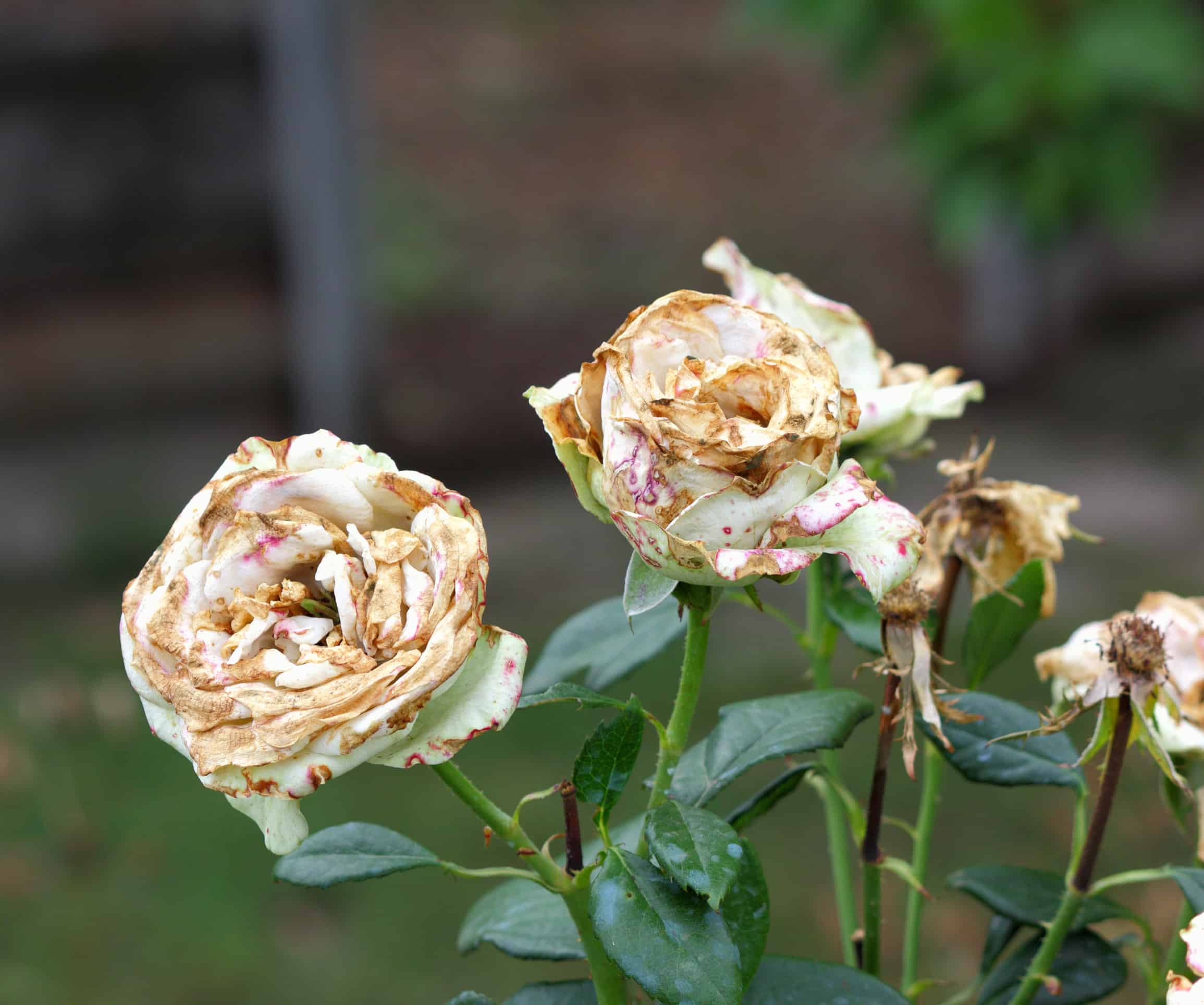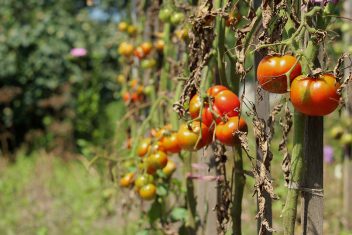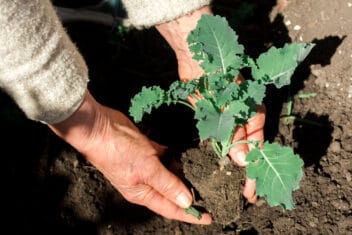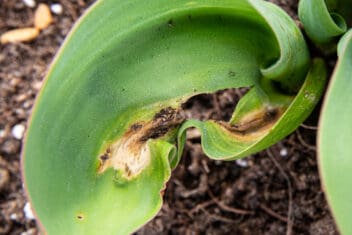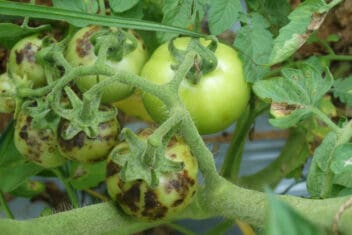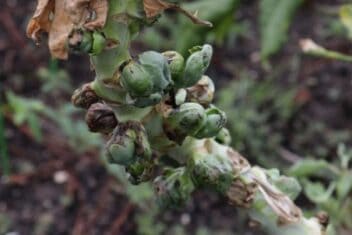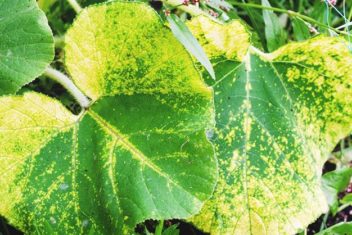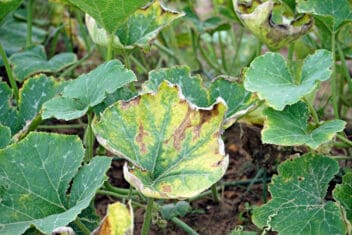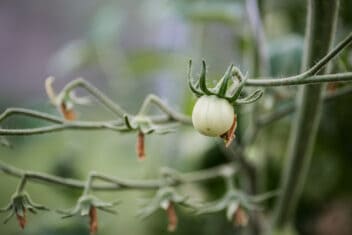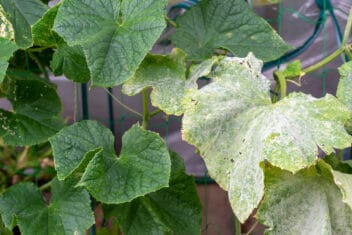Roses really are the darlings of the gardening world. After all, what garden design would be complete without their beauty and fragrance? Unfortunately, rose pests and problems are common, and any gardener who grows these blooms will have to contend with them eventually.
Let’s take a look at some of the most common issues that you may face when growing and tending rose bushes. Some are insect-related, while others have to do with deficiencies or pathogens.
Rose Pests
First, we’ll cover the insect issues you might have to contend with. These will vary depending on the cultivars you’re growing, as well as your locale and growing zone.
1. Rose Midges (Dasineura rhodophaga)
I only learned about these when they infected my miniature pink rose bush, which had to be dug up and burned to be rid of them. These midges live in the soil around rose bushes and like to sneak their way up into the buds.
Once there, they gnaw at the buds’ insides until they drop off, leaving your bushes sadly headless.
If your main rose pests are these midges, you need to deal with them ruthlessly. Dig up and burn any infected plants, remove any potentially infected soil and dispose of it like you’re dealing with hazardous materials.
Then treat the remaining soil with your insecticide of choice so they don’t come back. If you want to grow roses in that area again, let the soil rest and replenish with amendments for a year before planting new bushes.
Crying is absolutely okay.
*Note: Some evidence claims that removing mulch in late autumn and disposing of it might eliminate these midges as they hibernate. Try swapping it out for fresh mulch in an attempt to save your beautiful babies.
2. Fuller Rose Weevil (Naupactus cervinus)
Fuller rose weevils are little, brown, flightless snout beetles that chomp through the foliage on your plant. Underground, the larvae damage the root system. Left to their devices, they can kill a plant.
Start by handpicking the little buggers off the plant and drown them in soapy water. You can also trim away any branches that are near the ground. Then, put a piece of sticky trap tape (sticky side out) partially up the stem to catch the beetles as they climb up.
3. Aphids (Aphidoidea spp.)
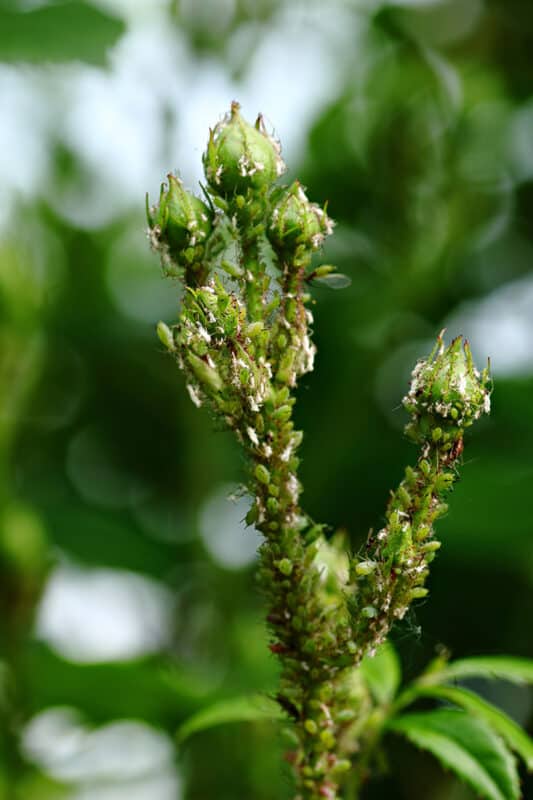
These awful little sap suckers are really quite insidious, aren’t they? I had to deal with aphids on my corn this year, and they were a pain to get rid of. You’ll mostly find them on young rose buds and leaves, and they’ll cause the leaves to deform, and blossoms to drop. Jerks.
Ladybugs work wonders on them, and you can also use soapy water or diatomaceous earth to get rid of them. I’ve even scraped them off leaves with an old credit card. You’ll have to snip off really damaged leaves and burn them, but that will make room for new growth.
4. Cane Borers
Now, cane borers are actually types of wasp larvae that infect freshly pruned rose canes. They can also affect raspberry and blackberry canes, also shortly after pruning.
The holes that are exposed after these plants have been pruned are attractive to wasps, so they lay their eggs down into the canes. As the larvae hatch and mature, they eat their way through them.
You can only get rid of these rose pests by pruning ruthlessly to get rid of the interior nest. Then seal the open hole with Elmer’s white glue so wasps can’t lay new eggs in there.
5. Root Knot Nematodes (Meloidogyne)
If you live in a hot climate and you’re wondering why your roses are failing to thrive, you may be dealing with these guys.
Root knot nematodes are parasites that attach themselves to rose roots. They create gall-like nodes on those roots, and prevent nutrients from being drawn into the plant (basically keeping it all for themselves).
Other than digging up your rose bushes and discarding them, the only way to treat these nematodes is with biocontrol agents such as Juglone, Paecilomyces lilacinus, and Pasteuria penetrans.
6. Metallic Flea Beetles (Altica sp.)
Do your rose leaves look like they’ve been chewed up? Then you might be dealing with Altica flea beetles. They start off quite small, but the holes they gnaw in your rose bushes will get bigger as the beetles grow.
The good news is that these rose pests only live in tropical and sub-tropical locales. Although they really love roses and berry bushes, your flowers are probably safe from them if you live in a cooler climate.
7. Rose Curculio Weevils (Merhynchites bicolor)
They may have a cool name, but these North American beetles will wreak absolute havoc on your roses. In fact, they can cause all kinds of damage to anything in the Rosaceae family but are particularly fond of flowering roses, blackberries, raspberries, and thimbleberries.
There’s not much you can do to fend them off, but since they’re quite large, you can pick them off your plants easily. Then just drop them into a soapy water solution to drown them.
8. Thrips (order Thysanoptera)
If your rose bushes look like they’ve been chewed and warped, you may be dealing with thrips. They’re tiny and look like miniature grains of rice, and they like to roll leaves into cigar-like tubes as they feed.
These rose pests can be dealt with fairly easily, however, so all is not lost. You can treat your plants with insecticidal soap, or even with concentrated dish soap or Castile soap solution. Just spray your rose bushes down thoroughly to get rid of these munchers.
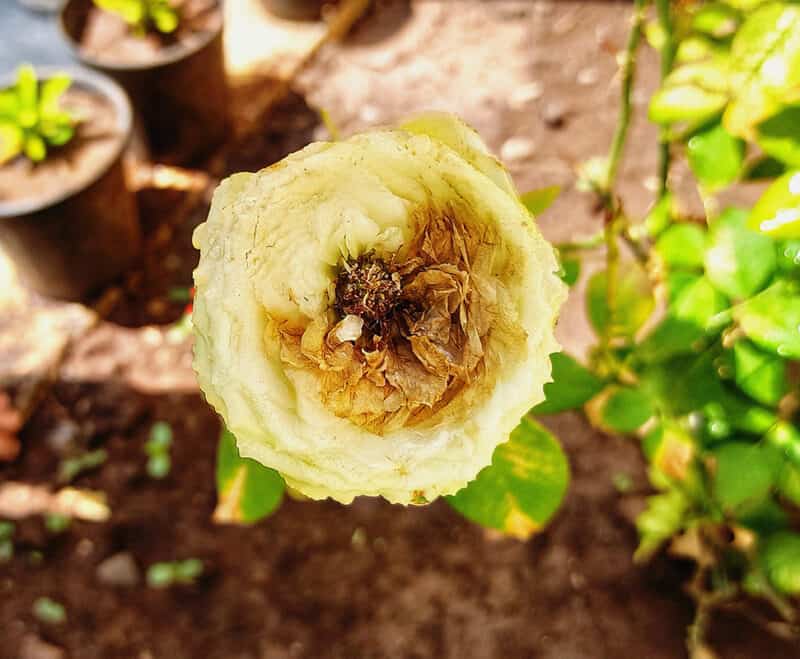
As an added note, thrips seem to prefer light-colored blooms. As a result, you may not have to deal with them if you’re growing dark red rose cultivars.
9. Caterpillars
Now, there are approximately a gazillion (actual number) different types of caterpillars that may be found on your roses at any given point in time. It all depends on where you live, and which butterflies and/or moths flourish in that region.
Tortrix moths (Lozotaenia forsterana) are particularly fond of them, and there are many others that specifically focus on eating roses. As far as rose pests go, however, caterpillars are pretty easy to deal with.
You can create sticky barriers on the stems that trap them when they try to crawl up them. Alternatively, just check your bushes diligently and pick off any caterpillars you see. Drop them into soapy water to drown them, or feed them to your chickens and/or guinea hens.
10. Leafcutter Bees (Megachilidae)
These bees do really spectacular things with leaves. They bite shapes out of them and transform them into egg cells. Furthermore, the bees are some of the best pollinators around and are great friends for your vegetable and herb gardens.
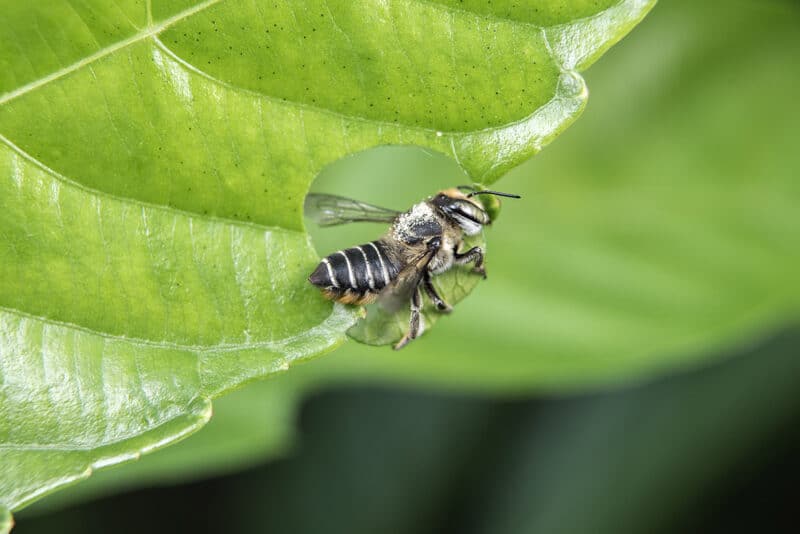
Unfortunately for floral gardeners, these bees really like rose leaves.
The good thing is that the damage they cause is just superficial. Sure, the roses’ leaves will look more than a little shredded, but the plants won’t be harmed. You’re growing roses for the blooms, so don’t fret or fuss about aesthetic damage to the leaves.
11. Sawflies (Caliroa cerasi)
I don’t know about you, but I hate these creatures. Their larvae are absolutely voracious and can turn a rose bush into a skeletal whisper of its former self in a matter of days. They love both leaves and young buds, but will also scar the stems where their eggs were laid.
Your best option for dealing with these rose pests is to encourage wild birds to visit your yard. Make sure there are seed feeders and clean, safe water sources nearby, and insectivorous avian friends will help to reduce the population, if not eradicate them completely.
If birds are reluctant to nom on these jerks, you can hose them down with a concentrated soap solution, so they bugger off elsewhere.
Be careful when using pesticides on sawfly larvae—even if it’s organic. Birds really do love to eat the larvae, but our feathered friends will die if they consume the harmful chemicals coating them.
12. Rose Chafers (Macrodactylus subspinosus)
These nasty little critters cause two different types of damage: as adult beetles, and as larvae.
The larvae are C-shaped and like to feast upon plant roots. As adults, the beetles love to eat rose and peony petals and leave massive, gaping holes in them that then turn brown.
You can inspect the soil around your roses’ roots in springtime to see if larvae are present, and then kill them by drowning them in soapy water. If you find adults in your mature rose blooms, drown them the same way.
13. California Red Scale (Aonidiella aurantii)
Scale insects are sap suckers, and incredibly difficult to get rid of. This is because they have a thick, waxy shell that protects them from insecticides and other traditional control methods. As a result, if and when these rose pests appear, you’ll need to take drastic action.
Although natural predators like ladybugs and various parasitic wasps can help manage scale bugs, your best bet is annihilation. Snip off any affected leaves and burn them. Check the rest of the rose bush regularly and diligently, as well as other plants nearby. Then burn, baby, burn.
Rose Diseases
Roses have a bit of a reputation as being disease-prone. There’s no denying that they’re attacked by a variety of bacteria and fungi. Here are the most common ones.
14. Rose Rust (Phragmidium)
Have you ever seen a rusty old fender on a beaten-up car? Well, rose rust presents a similar appearance. You’ll see blooms of red-yellow-brown spots on your plants, causing the leaves to curl up and die.
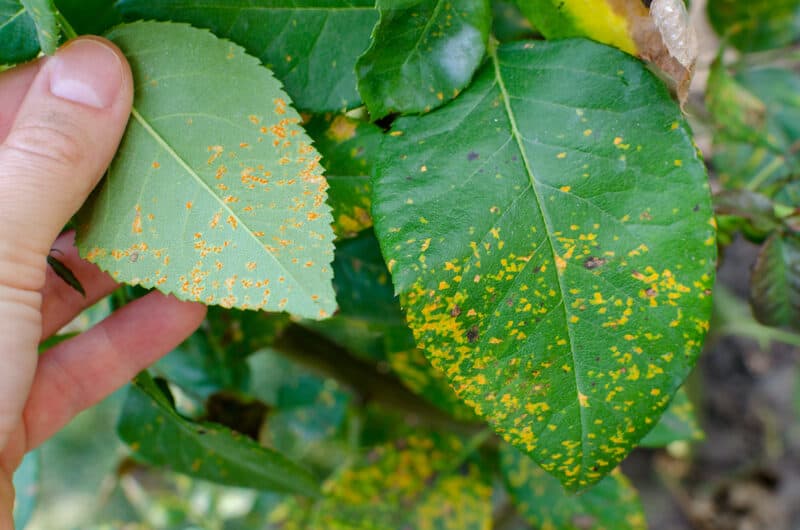
Rust is actually a type of fungus that prefers damp, cool conditions. This is why you’ll often see it in early spring, or late summer/early autumn, when the weather cools. Unfortunately, it’s also very difficult to eradicate.
Like most other types of fungus, rust spores like to stick around in the soil. If your rose bushes fall to this blight, you’ll need to burn all infected parts and dispose of at least three inches of soil as well.
15. Black Spot (Diplocarpon rosae)
This is a type of fungus that might afflict your rose bushes if they’re growing in shady spots. Black spot loves to thrive in humid, warm conditions, but it’ll be obliterated by direct sunlight. If you’re growing roses in the shade, however, then black spot has a chance to thrive.
It’s fairly easy to treat, thankfully: just whip together some homemade fungicide, and spray diligently every few days until it disappears. If possible, try to trim back overhead foliage that may be blocking sunlight from your rose bushes, as this will help as well.
*Note: Please yell “Out, black spot!” while you’re treating your plants—if not for your own amusement, then for mine.
16. Crown Gall (Agrobacterium tumefaciens)
If your rose bush has a weird-looking, tumorous growth just above the soil’s surface, you’re likely dealing with crown gall. Now, this bacteria is ugly: it actually integrates its DNA into the rose plant’s genome, so it’s really hard to eradicate.
It won’t destroy the bush because it’s symbiotic, but if you’re growing roses to sell, you’re out of luck. The blooms will still be pretty, but the stems will look tumorous. Normally, affected plants will just be dug up and destroyed, and the soil removed and/or blasted with chemicals to kill the bacteria.
If you’re really in love with the affected rosebush, however, there’s apparently a way to treat this disease. Basically, you need to do some horticultural surgery to cut out the gall, and then soak the roots in streptomycin for a few hours. Yes, that’s the antibiotic that’s used to treat tuberculosis.
Then you can replant the rose in fresh, clean soil.
17. Stem Canker (Coniothyrium spp.)
Are your rose canes covered in blotchy black spots? Then chances are you’re dealing with stem canker. It’s one of the most insidious rose pests, and easily avoidable with proper care.
Basically, canker is a type of pathogenic fungi that lives in the soil and thrives in cool, damp weather. In fact, it tends to attack roses in early spring and autumn, once temperatures have dropped. You can catch it early by snipping off affected areas with clean shears, but make sure to disinfect them thoroughly!
Many gardeners accidentally spread pathogens to healthy plants by not disinfecting their shears or snips properly. Wipe them down with bleach wipes or full-strength vinegar, and allow them to dry completely before using them again.
You can avoid stem canker entirely by making sure you plant your roses in sterilized soil. This is probably your best bet, as there’s no actual “cure” for this issue. Just aggressive snipping, and discarding contaminated soil. If your roses get this canker, apply fungicides into the surrounding soils, and don’t plant any other roses there for a few years.
18. Botrytis Blight (Botrytis cinerea)
Also known as “gray mold”, this blight is fungal in origin and likes to flourish on rose bushes during rainy periods. The roses get covered in grayish, sludgy fuzz (hence its moniker), and all the leaves and blooms rot and fall off.
Hybrid tea roses seem to be the most affected, so watch out for this blight if you’re growing them.
Be proactive with snipping off affected areas if they start to go fuzzy, and use some of the aforementioned homemade fungicides as a preemptive measure so it doesn’t spread. And remember to disinfect your shears! You absolutely do not want this to spread.
19. Spot Anthracnose Fungus (Colletotrichum graminicola)
This is also known as leaf or twig blight and thrives in cool, damp weather. It annihilated one of my maple trees a couple of years ago and likes to run rampant in early spring. You can identify it by the rust-colored spots that appear on rose leaves and petals like they have a case of the measles.
The good news is that it pretty much clears up on its own as soon as the weather heats up and dries out.
There isn’t a real treatment for this fungus per se, other than being fastidious about keeping the local areas clean. This blight lives in decaying plant matter, so if you keep the ground around your bushes clean, and clear away any/all fallen leaves quickly, it won’t have a chance to thrive (or spread).
20. Powdery Mildew (Eryspihe cichoracearum)
Powdery mildew is another pathogen that explodes in damp conditions. It’s particularly fond of cucurbits like melons and squashes but can wreak absolute havoc on your beautiful rose leaves as well.
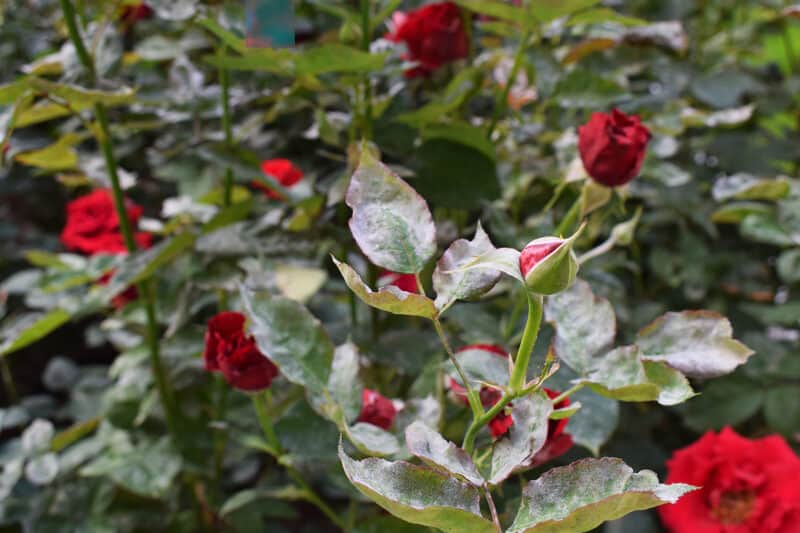
Fortunately, powdery mildew is treatable and fairly easy to counteract with a bit of diligent care.
First of all, make sure to prune your rosebushes regularly. Proper airflow will prevent this mildew from developing in the first place. If and when it does make an appearance, cut off affected areas, and douse your plants with a natural fungicide.
Then, apply compost tea as a foliar treatment every few days until everything looks happy and healthy again.
Rose Problems
All plants face problems that aren’t caused by pests or diseases. For roses, it’s often related to the climate that they’re growing in.
21. Sun Scorching
You might not think of sunshine as a potential problem when thinking about various rose pests, but it can be. Most roses thrive best in temperate climates, so extreme heat and intense sunlight in hotter climates can damage or even kill them.
If you’re in growing zones 9 and above, make sure to water your rose bushes well in the early morning, as well as late evening. Should you find that their leaves are browning and wilting, try to provide them with some shade during the hottest part of the day.
22. Cold Damage
This is the same issue as above but reversed. Unless you’re growing some really cold-hardy roses, they’ll suffer if exposed to chilly wind and frigid temperatures. Their canes will turn brown and the leaves will shrivel up and fall off.
If you’re growing roses in zone 5 and below, try to cultivate them in pots, rather than right in the ground. This way, you can either bring them inside when the weather cools, or transfer them into a greenhouse.
Roses may be a bit fussy when it comes to care and cultivation, but they’re so beautiful that they’re well worth the time and effort. There’s nothing quite like a garden full of gorgeous, fragrant blooms. Furthermore, with diligent care, you’ll be able to cut bouquets for your home all season long.
